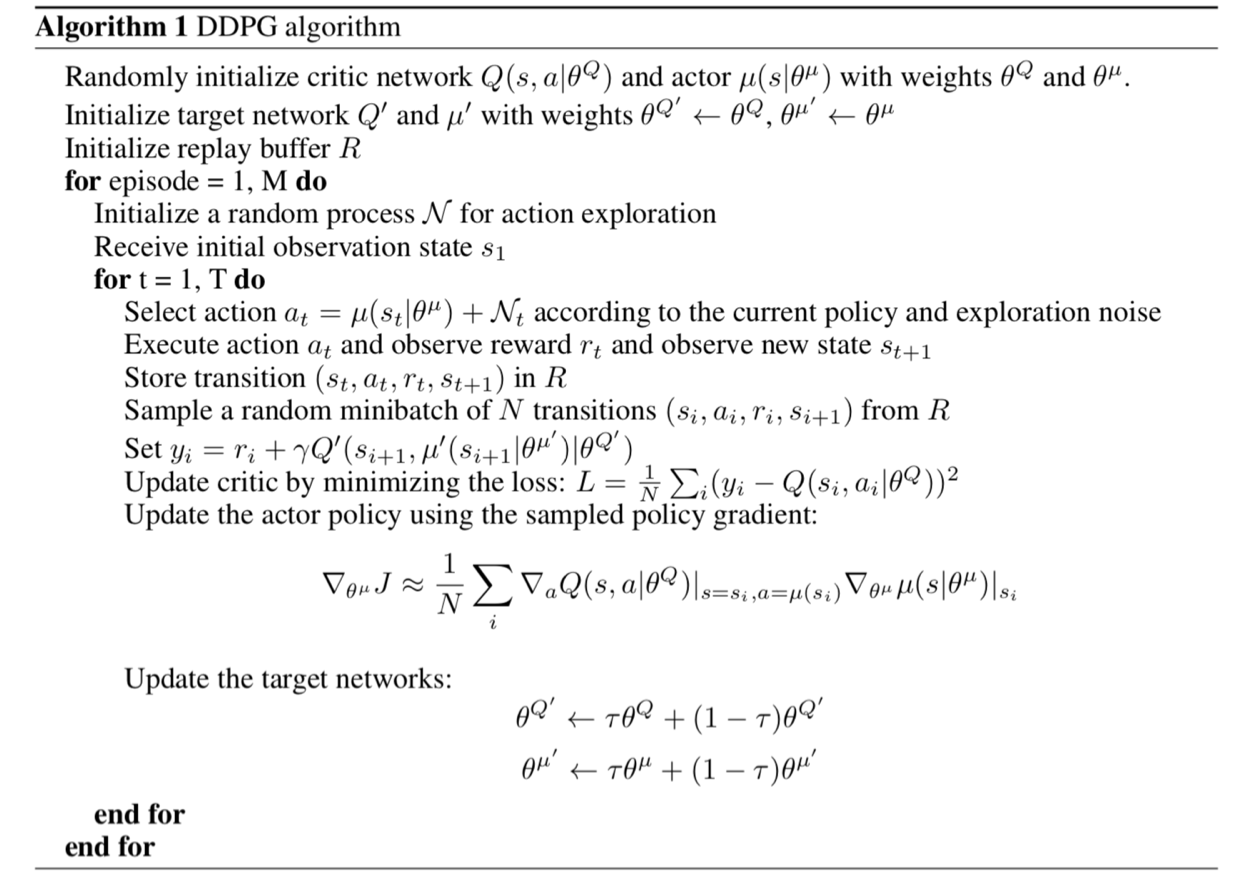你的DDPG/RDPG为何不收敛?
- DDPG不收敛的潜在原因分析
- RDPG不收敛的潜在原因分析(含Github上几个不能收敛的RDPG源码分析)
- D(R)DPG可以收敛的源码(分Keras和pytorch两种版本)
- 强化学习实践(编程)过程的几点建议
一:DDPG不收敛的潜在原因分析
先上DDPG的算法伪代码:
(1)在编写Q(s, a)的过程中,错误的使用了layer.Add层而非layer.concatenate (keras版)或torch.cat (pytorch版)
会导致不收敛的critic代码如下:
#程序清单1
1 from keras.layers import Add 2 #如下代码定义了critic网络 3 def _build_critic(self, featureDim, actionDim, learningRate=LR_C): 4 stateInputs = Input(shape = (featureDim, ), name = 'State-Input') 5 actionInput = Input(shape = (actionDim, ), name = 'Action-Input') 6 stateOut = Dense(30, activation = 'relu')(stateInputs) 7 actionOut = Dense(30, activation = 'relu')(actionInput) 8 Outputs = Add()([stateOut, actionOut]) 9 init = RandomUniform(minval = -0.003, maxval = 0.003) 10 Outputs = Dense(1, activation = 'linear', name = 'Q-Value', kernel_initializer = init)(Outputs) 11 critic = Model(inputs = [stateInputs, actionInput], outputs = Outputs)
12 return critic
不收敛原因的分析:写代码的时候一定要多想想Q(s, a)的本质是什么?Q(s, a)的本质是多键值的联合查表,即采用s和a作为键值在一个表格中查表,只不过这个表格用神经网络替代了。也就是说,作为键值,s和a一定要分别单独给出,而不能加在一起然后再给神经网络。
可以收敛的critic写法如下(Keras版):
#程序清单2
1 from keras.layers import concatenate 2 3 def _build_critic(self, featureDim, actionDim, learningRate=LR_C): 4 5 sinput = Input(shape=(featureDim,), name='state_input') 6 ainput = Input(shape=(actionDim,), name='action_input') 7 s = Dense(40, activation='relu')(sinput) 8 a = Dense(40, activation='relu')(ainput) 9 x = concatenate([s, a]) 10 x = Dense(40, activation='relu')(x) 11 output = Dense(1, activation='linear')(x) 12 13 model = Model(inputs=[sinput, ainput], outputs=output) 14 model.compile(loss='mse', optimizer=Adam(lr=learningRate)) 15 16 return model
(2)如果采用PyTorch编写actor神经网络,有一点要注意(经笔者实验,只有PyTorch有这个问题,Keras的coder可以放心的跳过这一节了)
使用PyTorch尽量不要使用Lambda层,实验结果上来看它似乎非常影响收敛性。尽管Keras上使用Lambda层不影响收敛性。
会导致收敛过程很坎坷甚至不收敛的actor代码如下:
#程序清单3
1 class Actor(torch.nn.Module): 2 def __init__(self, s_dim, a_dim): 3 super(Actor, self).__init__() 4 self.Layer1 = torch.nn.Linear(s_dim, 30) # Input layer 5 self.Layer2 = torch.nn.Linear(30, 30) 6 self.Layer3 = torch.nn.Linear(30, a_dim) 7 self.relu = torch.nn.ReLU() 8 self.tanh = torch.nn.Tanh() 9 10 def forward(self, s_input): 11 out = self.relu(self.Layer1(s_input)) # linear output 12 out = self.relu(self.Layer2(out)) 13 out = self.tanh(self.Layer3(out)) 14 out = Lambda(lambda x: x * 2)(out) 15 return out
注意到程序的第14行引用了Lambda层,笔者当时解决的问题是“Pendulum-v0”,对于该问题,合法的动作空间是[-2, 2]之间的。而13行的tanh输出在[-1, 1]之间。所以需要把13行的输出乘以2。但是笔者发现,这种写法收敛的过程相较不采用Lambda层而直接将out乘以2(代码之后给出)输出收敛的更慢,并且收敛的过程会被反复破坏然后再收敛,如下图:

上图的蓝线表示critic_loss, 橘线表示实时动作-状态值函数的预测输出。可以从上图(左)看到,在PyTorch中采用Lambda层规范动作值使得critic对动作-状态值函数的预测难以收敛,这表示它对critic的预测带来了负面的影响,总是不断的破坏critic的收敛性。上图(右)的代码如程序清单4中所示。直接将上一层网络的输出乘以2而没有使用Lambda层。可见critic的预测可以逐渐趋近于0(对于Pendulum-v0这是收敛,其他环境不趋于0),收敛性也好了很多。
可以收敛的actor写法如下:
#程序清单4
1 class Actor(torch.nn.Module): 2 def __init__(self, s_dim, a_dim): 3 super(Actor, self).__init__() 4 5 self.l1 = torch.nn.Linear(s_dim, 40) 6 self.l2 = torch.nn.Linear(40, 30) 7 self.l3 = torch.nn.Linear(30, a_dim) 8 9 def forward(self, x): 10 x = F.relu(self.l1(x)) 11 x = F.relu(self.l2(x)) 12 x = 2 * torch.tanh(self.l3(x)) 13 return x
(3)如果采用PyTorch编写critic神经网络,有一点要注意(经笔者实验,也是只有PyTorch有这个问题,Keras的coder可以放心的跳过这一节了)
在编写Q(s, a)的时候,s和a一定要在一开始输入神经网络的时候就做连接操作(上文提到的concatenate)而不要让s和a分别经过一层神经网络后再做连接操作。否则,critic会不收敛。
会导致不收敛的critic代码如下:
#程序清单5
1 class Critic(torch.nn.Module): 2 def __init__(self, s_dim, a_dim): 3 super(Critic, self).__init__() 4 self.Layer1_s = torch.nn.Linear(s_dim, 30) 5 self.Layer1_a = torch.nn.Linear(a_dim, 30) 6 self.Layer2 = torch.nn.Linear(30+30, 30) 7 self.Layer3 = torch.nn.Linear(30, 1) 8 self.relu = torch.nn.ReLU() 9 10 def forward(self, s_a): 11 s, a = s_a 12 out_s = self.relu(self.Layer1_s(s)) 13 out_a = self.relu(self.Layer1_a(a)) 14 out = self.relu(self.Layer2(torch.cat([out_s, out_a], dim=-1))) 15 out = self.Layer3(out) 16 return out

上图的蓝线表示critic_loss, 橘线表示实时动作-状态值函数的预测输出。上图(左)是程序清单5运行的结果输出。上图(右)是程序清单6运行的结果输出。
可以收敛的critic写法如下:
#程序清单6
1 class Critic(torch.nn.Module): 2 def __init__(self, s_dim, a_dim): 3 super(Critic, self).__init__() 4 5 self.l1 = torch.nn.Linear(s_dim + a_dim, 40) 6 self.l2 = torch.nn.Linear(40 , 30) 7 self.l3 = torch.nn.Linear(30, 1) 8 9 def forward(self, x_u): 10 x, u = x_u 11 x = F.relu(self.l1(torch.cat([x, u], 1))) 12 x = F.relu(self.l2(x)) 13 x = self.l3(x) 14 return x





【推荐】国内首个AI IDE,深度理解中文开发场景,立即下载体验Trae
【推荐】编程新体验,更懂你的AI,立即体验豆包MarsCode编程助手
【推荐】抖音旗下AI助手豆包,你的智能百科全书,全免费不限次数
【推荐】轻量又高性能的 SSH 工具 IShell:AI 加持,快人一步
· AI与.NET技术实操系列:向量存储与相似性搜索在 .NET 中的实现
· 基于Microsoft.Extensions.AI核心库实现RAG应用
· Linux系列:如何用heaptrack跟踪.NET程序的非托管内存泄露
· 开发者必知的日志记录最佳实践
· SQL Server 2025 AI相关能力初探
· 震惊!C++程序真的从main开始吗?99%的程序员都答错了
· winform 绘制太阳,地球,月球 运作规律
· 【硬核科普】Trae如何「偷看」你的代码?零基础破解AI编程运行原理
· 上周热点回顾(3.3-3.9)
· 超详细:普通电脑也行Windows部署deepseek R1训练数据并当服务器共享给他人